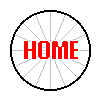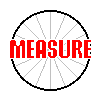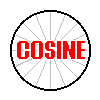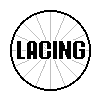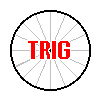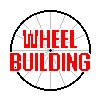



















| |
| |




















|
LACING PATTERNS THAT ARE
DIFFICULT OR WOULD NOT WORK
AND OTHER THINGS TO AVOID




















| |
| |




















|
There are a variety of lacing patters that can work and a few that cannot. One of the things you have to look out for is to make sure the spoke count of the pattern you want to build matches the characteristics of the hub and rim. A good example of this is the Crow's Foot pattern (see CROW'S FOOT LACING if you have not done so yet). Since each Crow's foot group of spokes is comprised of three spokes, the number of spoke holes has to be wholly divisible by three. Hubs and rims with 32 holes are popular, but if you tried to build a Crow's Foot wheel with these hubs and rims it would not work. If you divide 32 by 3 you get 10.666 (10 2/3). You would end up with two hub holes and two rim holes that would not have a spoke. The CROW'S FOOT LACING chapter does explain a hybrid Crow's Foot pattern that will work on 32 spoke wheels.
You have to make sure the spokes won't hit the bearing cups when they cross on the inside of the flanges. This can happen with lacing patterns where the SAA is greater than 90 degrees. You might be able to go one hole past the 90 degree mark, but probably not two. There is nothing about a lacing pattern with so much cross that a SAA of greater than 90 degrees makes it an attractive or technically useful pattern. The greatest leverage factor for drive torque transfer in a rear wheel, and braking torque transfer in any wheel, is a SAA of 90 degrees. If you built a wheel with spokes that went past the SAA 90 degree point the resulting leverage factor would be the same as if the spoke was the length of the spoke it directly passes as it crosses the hub flange. Even though leverage is not a factor for rim braked front wheels, a lacing with a SAA of greater than 90 degrees is not practical, it just adds needless mass to the wheel. For example, a 36 spoke wheel built with 5-cross spokes has the same physical properties as if it was built with 3-cross spokes.
Problems can arise with too many crosses during the construction and repair of a wheel. You want to lace the wheel so the spokes rest against the hub flange of only slightly touch the head of the first spoke it crosses. You do not want the spokes to rest right on top of the heads of other spokes. If a spoke crosses right over the head of another spoke a high stress point is created and the spoke might also move from road shock and general riding stresses. This condition makes the wheel unreliable. With 36 spoke wheels 2-cross and 3-cross lacing's work well, but a 4-cross lacing might cause the problem just described. For 32 spoke wheels 4-cross lacing spokes can also cause this problem and for 48 spoke wheels 6-cross lacing spokes might cause problems.
Another problem that can occur with the spoke lengths detailed above deals with repair of the wheel. With the spokes crossing right over the heads of other spokes, if a spoke breaks, you will need to relieve the tension of, and possibly totally free, at least one other spoke in order to get the head of the broken spoke out and the new spoke in. This does nothing but increase the work of repairing the wheel.
When you would be building a wheel where the spokes overlap the heads of others, one spoke would block the flange hole for another spoke, making threading the spokes difficult. You would probably have to place all of the spokes in the hub first, before lacing any to the rim, which will increase the complexity of the build. It is the easiest to build wheels with the spokes divided into sets of four (for standard cross lacing's), one set of 'pull' spokes and one set of 'push' spokes for each hub flange, starting with the spokes that anchor to the inside of the flange's (heads out).
Another thing you cannot do when you build a wheel is to use random lacing patterns. While you can build mixed lacing rear wheels that have different lacing patterns on each side (see STRONG REAR WHEEL LACING), and you can mix lacing patterns evenly on one side of a wheel (see CUSTOM LACING PATTERNS) you cannot randomly mix lacing patterns on a wheel. For example, you have some unused spokes of different lengths, so you build a wheel where you use a few 3-cross patterns, a few 2-cross patterns, maybe a few 1-cross patterns, and fill in the rest with radial spokes. This would make a wheel that has unbalanced build tensions and stresses. It would not handle ride stresses very well. A wheel built like this would be very unreliable and could even completely fold up when you hit a good bump or flew off a jump. When you build spoked wheels there are hundreds of static tensions and stresses and they must all have an equivalent tension and stress to balance against. The static tensions and stresses are the forces acting on the wheel just from the wheel build.
|
OTHER CHAPTERS: GENERAL WHEEL LACING REAR WHEEL FACTORS RADIAL LACING INFORMATION CROW'S FOOT LACING STRONG REAR WHEEL LACING LACING A WHEEL OFF-CENTER LACING PATTERNS THAT ARE DIFFICULT OR WOULD NOT WORK AND OTHER THINGS TO AVOID SPOKE LENGTH TOLERANCE FIXES FOR SOME PROBLEMS CUSTOM LACING PATTERNS |
